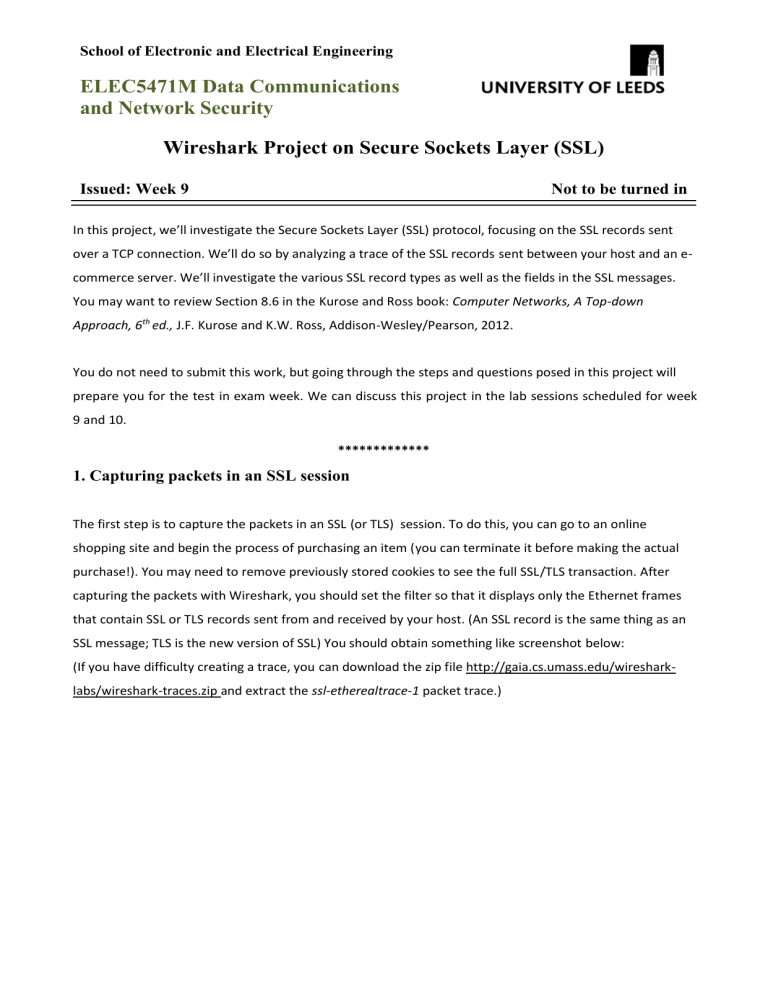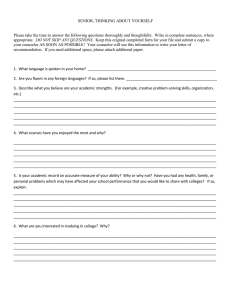
School of Electronic and Electrical Engineering ELEC5471M Data Communications and Network Security Wireshark Project on Secure Sockets Layer (SSL) Issued: Week 9 Not to be turned in In this project, we’ll investigate the Secure Sockets Layer (SSL) protocol, focusing on the SSL records sent over a TCP connection. We’ll do so by analyzing a trace of the SSL records sent between your host and an ecommerce server. We’ll investigate the various SSL record types as well as the fields in the SSL messages. You may want to review Section 8.6 in the Kurose and Ross book: Computer Networks, A Top-down Approach, 6th ed., J.F. Kurose and K.W. Ross, Addison-Wesley/Pearson, 2012. You do not need to submit this work, but going through the steps and questions posed in this project will prepare you for the test in exam week. We can discuss this project in the lab sessions scheduled for week 9 and 10. ************* 1. Capturing packets in an SSL session The first step is to capture the packets in an SSL (or TLS) session. To do this, you can go to an online shopping site and begin the process of purchasing an item (you can terminate it before making the actual purchase!). You may need to remove previously stored cookies to see the full SSL/TLS transaction. After capturing the packets with Wireshark, you should set the filter so that it displays only the Ethernet frames that contain SSL or TLS records sent from and received by your host. (An SSL record is the same thing as an SSL message; TLS is the new version of SSL) You should obtain something like screenshot below: (If you have difficulty creating a trace, you can download the zip file http://gaia.cs.umass.edu/wiresharklabs/wireshark-traces.zip and extract the ssl-etherealtrace-1 packet trace.) 2. A look at the captured trace Your Wireshark GUI should be displaying only the Ethernet frames that have SSL records. It is important to keep in mind that an Ethernet frame may contain one or more SSL records. (This is very different from HTTP, for which each frame contains either one complete HTTP message or a portion of a HTTP message.) Also, an SSL record may not completely fit into an Ethernet frame, in which case multiple frames will be needed to carry the record. When answering a question below, it may be useful to include a copy/screenshot of the packet(s) within the trace that you used to answer the question asked. Annotate and/or highlight your selection to explain your answer. If you need to print a packet, use File->Print, choose Selected packet only, choose Packet summary line, and select the minimum amount of packet detail that you need to answer the question. Now, for the trace that you have picked, go through the following questions and see if you can answer them by finding the relevant parts in the trace. 1. For each of the first 8 Ethernet frames, specify the source of the frame (client or server), determine the number of SSL records that are included in the frame, and list the SSL record types that are included in the frame. Draw a timing diagram between client and server, with one arrow for each SSL record. 2. Each of the SSL records begins with the same three fields (with possibly different values). One of these fields is “content type” and has length of one byte. List all three fields and their lengths. ClientHello Record: 3. Expand the ClientHello record. (If your trace contains multiple ClientHello records, expand the frame that contains the first one.) What is the value of the content type? 4. Does the ClientHello record contain a nonce (also known as a “challenge/random”)? If so, what is the value of the challenge in hexadecimal notation? 5. Does the ClientHello record advertise the cyber suites it supports? If so, in the first listed suite, what are the public-key algorithm, the symmetric-key algorithm, and the hash algorithm? ServerHello Record: 6. Locate the ServerHello SSL record. Does this record specify a chosen cipher suite? What are the algorithms in the chosen cipher suite? 7. Does this record include a nonce? If so, how long is it? What is the purpose of the client and server nonces in SSL? 8. Does this record include a session ID? What is the purpose of the session ID? 9. Does this record contain a certificate, or is the certificate included in a separate record. Does the certificate fit into a single Ethernet frame? Client Key Exchange Record: 10. Locate the client key exchange record. Does this record contain a pre-master secret? What is this secret used for? Is the secret encrypted? If so, how? How long is the encrypted secret? Change Cipher Spec Record (sent by client) and Encrypted Handshake Record: 11. What is the purpose of the Change Cipher Spec record? How many bytes is the record in your trace? 12. In the encrypted handshake record, what is being encrypted? How? 13. Does the server also send a change cipher record and an encrypted handshake record to the client? How are those records different from those sent by the client? Application Data 14. How is the application data being encrypted? Do the records containing application data include a MAC? Does Wireshark distinguish between the encrypted application data and the MAC? 15. Comment on and explain anything else that you found interesting in the trace.


